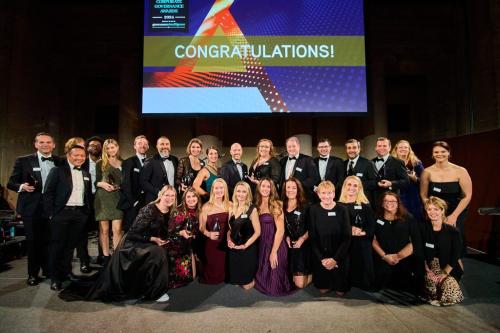This special section was sponsored by Stanford Law School Executive Education and UCLA Anderson School of Management.
The avalanche of new regulations in post-Enron America may have spurred many corporate secretaries to send their directors back to school, but mastering the nuances of compliance isn’t the only aim of director education. The top-notch courses teach the nuts and bolts, of course, but they also hone directors’ strategic skills – a far more difficult feat to accomplish.
‘The whole focus is moving from the technical compliance side that came about from Sarbanes-Oxley to how directors can do things intelligently, efficiently and in the interest of shareholders,’ says Prof Al Osborne, senior associate dean at the UCLA Anderson School of Management. ‘We’re seeing a real interest in directors being able to contribute to the business in a significant way, rather than just police it.’
Dan Siciliano, co-director of Stanford Law School’s Directors’ College and executive director of its program in law, economics and business, adds that tackling strategic issues is, after all, what directors are supposed to do – and what they do best. ‘Most directors don’t join a board in the hope that they will get to talk a lot about audit functions. They join a board because they have lots of great skills and think they can contribute because they’re a public relations master or a technology whiz,’ he says.
Companies are also emphasizing broader goals when they send their directors to an external education event. John Donnan, corporate secretary and general counsel for Kaiser Aluminum, which expects to emerge soon from Chapter 11, is considering how best to educate the individuals who will sit on the company’s post-emergence board.
‘Education empowers directors. If you’re going to be on the board and have a voice, you need to exercise it,’ says Donnan, who plans to send Kaiser’s new directors to an external education program in the near future. When Donnan broached the idea with the new recruits, ‘everyone,’ he says, ‘was enthusiastic.’
Keeping it practical
Given directors’ busy schedules, experts agree that education must be timely and relevant. Siciliano says executive compensation is a good example of a topic that can easily be mishandled.
‘What directors want to hear is not Don’t pay your CEO too much. That’s fairly obvious,’ says Siciliano. ‘They want very specific examples and tools.’ Directors, he adds, need practical advice for interacting with outside counsel and consultants. They also want guidance for negotiating pay rates, information on the best ways to construct credible comparisons when formulating compensation plans, the most appropriate sector and industry peer groups to use as well as concrete examples of directors who have prevailed in tough executive compensation situations.
If possible, directors would also like an opportunity to talk with the people who actually draft the rules. Board members, according to Siciliano, want moderated access to the chairman of the SEC and other regulatory agencies, as well as to the shareholder activists hankering for reform.
Siciliano’s argument is backed by the experiences of actual directors. After working at PricewaterhouseCoopers for more than 30 years, Dean Yoost recently joined his first two boards: Emulex in Costa Mesa, Calif, and UnionBanCal in San Francisco. Last year, Yoost attended external director education programs at Harvard Business School and UCLA, and he was impressed by the wealth of ‘real-life examples.’
‘Directors do not want to waste their time,’ emphasizes Siciliano. ‘They’re saying, Give me relevant issues, give me answers that are meaningful to me and let me go home with ideas that I can apply right then and there.’
Professionalization
Along with the growing interest in director education comes increased competition, and not all director education is taught at universities. Indeed, many professional organizations and industry groups, including the National Association of Corporate Directors (NACD), also offer programs. Now that so many director education programs have cropped up, Institutional Shareholder Services (ISS) is providing accreditation to help corporate secretaries evaluate their options.
While accreditation may serve as a seal of approval, it hardly tells a corporate secretary which program to pick. ‘Accreditation only takes you to one level,’ says Osborne. ‘If everyone’s accredited, you have to do a little more.’ Osborne urges corporate secretaries to ‘look for where the leading thinkers are and for a program that’s consistent with what you’re trying to do in your boardroom.’
Although Siciliano agrees that the very best programs easily reach the accreditation requirements, he thinks that some non-accredited programs also serve a purpose. They may, for instance, be narrow in focus or achieve an outcome that doesn’t specifically fit with accreditation.
That said, Siciliano notes that accreditation does have practical advantages. ‘If your CGQ [corporate governance quotient] matters to your company, ISS accreditation is a consideration because it will impact that,’ he says. It can save you money, too. Some D&O insurance providers also offer special rates for companies that take director education seriously.
When to send directors to school?
According to Yoost, while conventional wisdom dictates that directors attend an outside education program every two years, he plans to return more often – hopefully each year. ‘It makes sense to take a few days away and think about what you’re doing as a director,’ he says, adding that two days is ideal for any outside director education event. ‘Longer than that,’ he says, ‘and you get worn out.’
Siciliano advises corporate secretaries to look at director education on a three-year cycle. He recommends that public companies run a dedicated program in-house, but that corporate secretaries supplement these ongoing efforts by sending perhaps a third of all directors to an external education event each year. That way, a significant portion of the board is getting a refresher on the latest thinking on a yearly basis, and that will filter through to the rest of the board.
The social dimension
Networking may seem like a fluffy goal to some – but in this day and age, it’s essential. Siciliano emphasizes that one of the greatest advantages of external education is not the traditional educational benefit, but the opportunity to meet a broader universe of directors and thus learn through a sharing of ideas, or ‘cross-pollination,’ as he terms it. These contacts can then serve as a support and advice network in the future.
Given heightened concerns about governance, Siciliano applauds the fact that individuals now sit on fewer boards. However, he says this new standard has led to ‘one negative, unintended consequence; that is, the opportunity to learn from other board members in other environments and in other companies has been substantially reduced.’
Because directors need to bounce ideas off one another, Siciliano advises corporate secretaries to actively seek out programs that provide plenty of opportunities for constructive dialogue, not only with peers but other members of the business community as well. ‘Is the session you’re going to attend sufficiently interactive, so it’s not a you-sit-and-listen kind of affair?’ he asks.
Directors echo this sentiment. Mark Kaminski, a board member at Reliance Steel and Aluminum, observes, ‘It’s good to get outsiders’ views, so the board doesn’t get too insular.’
Siciliano and Osborne agree that nothing can replace the unique give-and-take aspect of a formal academic program. ‘Business judgment isn’t something you can learn from a computer or from an online chat room,’ says Osborne. ‘You need to be at luncheons, to walk to classes, to be part of an afternoon social libation. And you must be able to develop the most important ingredient directors have: the ability to trust one another’s judgments and reasoning as they try to collectively do the shareholders’ work.’
Stanford:
Access to the key players
For years, director education programs were viewed as a plum executive perk – something that board members were clamoring to attend. Nowadays, however, as the responsibilities falling on directors’ shoulders continue to increase dramatically, enrolling your company directors in an external education program can backfire.
‘I’d urge corporate secretaries to make sure that a director who shows up doesn’t think he or she knows more than the panelists,’ says Dan Siciliano, co-director of Stanford Law School’s Directors’ College. ‘Heaven forbid that a director comes back and tells the CEO or chairman that the program was a waste of time.’
Having made its start in director education twelve years ago, Stanford prides itself on inviting key decision makers to serve as panelists. ‘We have the actual authors, enforcers, policymakers and activists,’ says Siciliano. ‘You want them on the stage so that directors can ask them questions and interact – and in some cases, those policymakers are able to listen to what the directors have to say and take it under advisement when considering future policies and guidance. It can be a two-way street.’
At recent meetings, for instance, Stanford’s panelists have included SEC chairman Christopher Cox and former Hewlett-Packard CEO Carly Fiorina. This June, Stanford’s presenters will include such luminaries as John Thain, chief executive at the New York Stock Exchange; Robert Greifeld, president and CEO at Nasdaq; Charlie Munger, board member of Berkshire Hathaway; and Linda Thomsen, deputy director at the SEC’s department of enforcement. ‘We’re fortunate to have the A-list of participants here,’ says Siciliano.
Stanford is so committed to providing easy access to faculty and presenters that it caps enrollment at around 190 attendees per three-day session. With 80 instructors and panelists and another eight keynote speakers, the attendee-to-presenter ratio is nearly two to one. This ensures that the maximum level of useful, personal interaction takes place.
An ever-evolving program
Each year, Stanford’s annual director education event revolves around three foundational areas: compensation, audit and litigation. In addition, Stanford offers twelve breakout sessions on topics ranging from crisis management to director liability exposure to hedge funds and their role in investing, says Siciliano.
Stanford also regularly changes its breakout topics to meet directors’ evolving needs. This June, for instance, Stanford is piloting a session on nonprofits and a ‘freakonomics’ session aimed at giving a ‘down and dirty’ look into some of the pension, healthcare and financial topics about which directors increasingly need to be informed. Stanford is also adding CEO successions to its curriculum.
Holding one major event a year makes sense, given directors’ frenetic schedules, says Siciliano. This year, Stanford will hold its program from June 25 to June 27.
In addition, the university sponsors several shorter, local events for directors throughout the year. For instance, Stanford is hosting a one-day event in conjunction with the SEC in early April in Washington, DC, at which various academics will comment on the new executive compensation rules. Siciliano estimates that another 500 directors participate in Stanford’s half-day, evening or occasional events each year.
Whether it’s a two-day program or a brief seminar, Siciliano circles back to the caliber of presenters and attendees. ‘No matter how a program is constructed, half of the value is who attends – and their contributions,’ he concludes. ‘What pleasantly surprises attendees at Stanford is that to the left and to the right are people they would have paid money to consult with, and they’re happy to chat with them.’
For more information:
Please call (650) 723-5905,
e-mail [email protected]
or visit www.directorscollege.com
UCLA:
Tailoring programs to directors’ needs
This spring, UCLA will extend its two-day director education program to four days to give attendees a greater range of choices, according to Prof Al Osborne, senior associate dean at the UCLA Anderson School of Management.
‘We believe that our offering is unique for the flexibility, modularity and range of choices we offer participants,’ explains Osborne. The optional first day of the program is designed with less experienced directors in mind. The core two-day program then focuses on more advanced issues as well as analytically driven topics of management. And on the fourth day, UCLA runs parallel modules for members of the governance, audit, compensation or other board committees.
‘The notion of one size fits all just doesn’t work anymore,’ says Osborne. ‘We can draw and bring to life governance as an area of study for both the less experienced and more experienced director because of our flexible, four-day format.’
UCLA, which has offered director education for twelve years now, regularly modifies its offerings to meet directors’ needs. Osborne emphasizes that there will be more courses on strategy this year, given that directors are thinking about markets in whole new ways.
One thorny issue that UCLA addresses is who should set and monitor the board meeting agenda. ‘We discuss the tenuous relationship between the chairman of the board and the CEO, who sometimes is the same person,’ says Osborne. ‘We want substantive, meaningful conversations that peel back the veneer of congeniality and allow people to be real. And one of the things we do to stay up with the new thinking is to modify our program every few years.’
A rigorous program
Osborne underscores that UCLA offers a rigorous program and assesses participants at the end of the course to ensure that they have gained the maximum benefit possible. ‘People are held accountable for what they have learned with the certification examinations they go through,’ he says.
UCLA’s current 90-minute exam may be the first step toward even more formalized requirements. ‘One day, corporate directors may have to be certified – going beyond current accreditation,’ speculates Osborne. ‘You may need to take a refresher course every few years.’
UCLA’s test doesn’t mean the program discourages socializing – just the opposite. UCLA intentionally keeps its courses small, capping enrollment at 40-50 directors, but on the opening evening of major events, UCLA holds a large reception to which it invites all alumni of the program. Often, 150 directors show up to the event, allowing current enrollees to network with a far wider group of directors than those individuals participating in their structured classes, says Osborne.
Dean Yoost, a director at both Emulex and UnionBanCal, views his time at UCLA as a valuable networking opportunity. ‘Our group had about 50 participants, both board members and CEOs, and I’ve maintained good contact with those individuals,’ he notes. For Yoost, who is based in Irvine, Calif, the fact that UCLA tends to attract other West Coast attendees was a definite plus because it makes it easier to maintain relationships.
‘A director works in a collaborative way with other directors,’ explains Osborne. ‘An educational experience that affords an opportunity for participants to talk to each other is probably going to be the most valuable because of the peer relationships and social networks.’
UCLA’s program is currently held twice a year, with the next session scheduled for May 16-19. But in keeping with its spirit of flexibility, UCLA is considering adding even more sessions down the road. ‘If demand continues, we may well have to go to three times a year,’ concludes Osborne.
For more information:
Please call the Office of Executive Education Programs
at (310) 206-1301, e-mail [email protected]
or visit www.execed.anderson.ucla.edu








